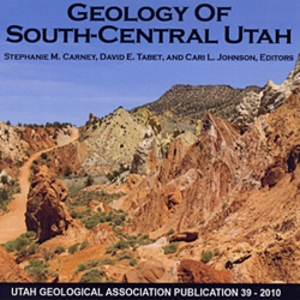Cyclic stratigraphy of the Paleogene Pine Hollow Formation and detrital zircon provenance of Campanian to Eocene sandstones of the Kaiparowits and Table Cliffs basins, south-central Utah
Larsen, Joseph S., Link, Paul K., Roberts, Eric M., Tapanila, Leif, and Fanning, C. Mark (2010) Cyclic stratigraphy of the Paleogene Pine Hollow Formation and detrital zircon provenance of Campanian to Eocene sandstones of the Kaiparowits and Table Cliffs basins, south-central Utah. In: Carney, Stephanie M., Tabet, David E., and Johnson, Cari L., (eds.) Geology of South-Central Utah. Utah Geological Association Publication . Utah Geological Association, Salt Lake City, UT, USA, pp. 194-224.
![[img]](https://researchonline.jcu.edu.au/16335/6.hassmallThumbnailVersion/16335_Larsen_et_al_2010_Cover.jpg)
|
Image (JPEG) (Book Cover)
- Cover Image
Download (156kB) |
|
|
PDF (Published Version)
- Published Version
Restricted to Repository staff only |
Abstract
We present the results of a sedimentological analysis of the Paleogene Pine Hollow Form-ation, coupled with detrital zircon geochronology of nine Upper Cretaceous-Paleogene fluvial sandstone samples from the Kaiparowits and Table Cliffs basins, southern Utah. Both sandstone petrology and detrital zircon geochronology suggest that specific parts of the Campanian (Upper Cretaceous) sandstones of the Kaiparowits and Wahweap Formations were derived either from the southwestern Cordilleran magmatic arc through the northeast-flowing “California River” system, or from transverse drainages that flowed out of the thrust belt to the west. As the basin became more isolated due to the development of Laramide uplifts, the magmatic arc provenance signal was disrupted, beginning during deposition of the latest Cretaceous or early Paleogene Canaan Peak Formation. Magmatic arc provenance disappeared completely in the Paleogene Pine Hollow and (overlying) Claron Formations as the Table Cliff syncline developed, which disrupted earlier regional depositional patterns. The Pine Hollow Formation contains four or five decimeter-scale, fining upward, conglomerate to mudstone cycles that formed as alluvial fans and braided streams repeatedly dried and transitioned into playa lakes. The cycles themselves become finer grained upwards and are interpreted to represent the transition from an overfilled low-accommodation systems tract to an underfilled high-accommodation systems tract. The formation was deposited under increasingly arid conditions, which led to progressively thicker playa deposits. Four detrital-zircon samples collected from the 80 m thick Pine Hollow Formation contain mainly Paleozoic and older populations. They lack Mesozoic-age magmatic arc zircons and have statistically identical grain-age populations, suggesting a uniform quartzose-recycled provenance reworked from subjacent Cretaceous sandstones uplifted on the limbs of the Table Cliff syncline. This study provides an important window into basin development, paleoclimate and fluvial drainage evolution associated with the transition from the Sevier to Laramide tectonics in the southern Cordilleran region.
| Item ID: | 16335 |
|---|---|
| Item Type: | Book Chapter (Non-Commercial) |
| ISBN: | 978-0-9800489-2-6 |
| Related URLs: | |
| Date Deposited: | 10 Nov 2011 03:03 |
| FoR Codes: | 04 EARTH SCIENCES > 0403 Geology > 040311 Stratigraphy (incl Biostratigraphy and Sequence Stratigraphy) @ 100% |
| SEO Codes: | 97 EXPANDING KNOWLEDGE > 970104 Expanding Knowledge in the Earth Sciences @ 100% |
| Downloads: |
Total: 241 Last 12 Months: 4 |
| More Statistics |



